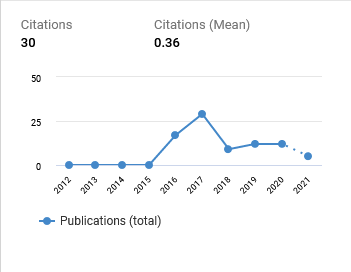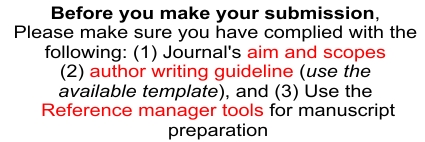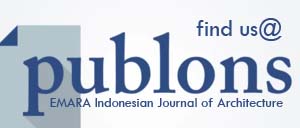Advancing Social Capital through Participatory Approaches
Case of Community-Based Slum Upgrading in Yogyakarta, Indonesia
DOI:
https://doi.org/10.29080/emara.v4i1.174Keywords:
social capital, community, participatory, slum upgrading, Gotong RoyongAbstract
Social capital discourse has come to be the foremost and essential aspects in achieving sustainable development, participatory democracy and just cities. Indonesia is like most Asian countries where people spatially and socially co-live in a community that is related to a network of small clusters. However, the formal study related to social capital is hardly founded. Based on its characters, Gotong Royong which is a socio-cultural ethic of the togetherness philosophy in Indonesia can be perceived as an Indonesian social capital practice. Advancing social capital through participatory approaches will need a deep consideration about the role of professional and community engagement. Successful collaborations between wider actors in participatory approaches could lead to a fundamental transformation that can both preserve and nurture social capital values. High level of social capital within communities can potentially underpin the successful community participation towards communal goals.
Downloads
References
ACHR. (2010). Community architects in Asia - design with by for people, Bangkok: ACHR.
Archer, D. (2009). Social Capital and Participatory Slum Upgrading in Bangkok, Thailand. Cambridge: Doctoral Dissertation Departement of Land Economy, University of Cambridge.
Arkomjogja. (2015). KALIJAWI Paguyuban Warga Bantaran Sungai Wong dan Winongo Yogyakarta. Yogyakarta: Kali Jawi - Arkomjogja.
Boano, C. (2014). Archiecture of Engagement: Informal urbanism and design ethics. Atlantis Magazine, 24(4), pp. 24-28.
Boano, C. & Hunter, W. (2013). Recalibrating Critical Design Practice: Excursions through Studio Pedagogy. In: Contested Urbanism in Dharavi: Writings and projects for the resilient city. London: Development Planning Unit, University College London.
Boano, C. & Kelling, E. (2013). Towards an Architecture of Dissensus: Participatory Urbanism in South-East Asia. The Participatory Turn in Urbanism , pp. 41-62.
Boano & Talocci, G. (2014). The inoperative power architecture and the reclaim of social relevance, London: Studio Magazine.
Boonyabancha, S. (2009). Land for housing the Poor, by the poor: Experiences from the Ban Mankoong Nationwide Slum Upgrading Programme in Thailand. Environment and Urbanization, 21(2), pp.309-329.
Boonyabancha, S. (2010). A note from interviews in Bangkok: Community Movements in Asia. In: Design by with for people. Bangkok: Asian Coalition for Housing Rights, pp.2-4.
Boonyabancha, S., Carcellar, F. & Kerr, T. (2012). How poor communities are paving their own pathways to freedom. Environment & Urbanization, 24(2), pp. 441-462.
Bourdieu, P. (1986). The Forms of Capital. In: J. F. Richardson, ed. Handbook of Theory of Research for Sociology of Education. CT: Greenword Press, pp. 241-58.
Bowen, J. R. (1986). On the political construction of tradition. The Journal of Asian Studies , p. 45.
Butcher, H. (1993). Intoductuon: Some Examples and Definitions. In: H. Butcher, A. Glen, P. Henderson & J. Smith , eds. Community and Public Policy. London: Pluto Press, pp.3-21.
CAN. (2011). Comprehensive site planning, Transform community to better living place for all. Bangkok: Community Architect Network .
Chimankar, Digambar A (2016). Urbanization and Condition of Urban Slums in India. Indonesian Journal of Geography, pp.28-36
Cleaver, F. (2001). Institution, Agency, and the Limitations of Participatory Approaches to Development. In: B. Cooke & Kothari, Uma, eds. Participation: The New Tyranny?. London: Zen Books Ltd, pp.36-55.
Coleman, J. (1988). Social Capital in the Creation of Human Capital. American Journal of Sociology, 94(5), pp.95-121.
Colletta, N. J. & Cullen, M. L. (2000). The nexus between violent conflict, social capital and social cohesion : case studies from Cambodia and Rwanda. In: C. Grootaert & T. v. Bastelaer, eds. The Role of Social Capital in Development An Empirical Assessment. Cambridge: Cambridge University Press, pp. 279-309.
Cooke, B. & Kothari, Uma. (2001). The Case for Participation as Tyranny. In: B. Cooke & U. Kothari, eds. Participation: The New Tyranny. London: Zed Books Ltd, pp. 1-15.
Cuthbert, A. (2007). Urban design: requiem for an era - review and critique of the lasr 50 years. Urban Design International, Volume 12, pp. 177-223.
Day, P. (2002). Designing Democratic Community Networks: Involving Communities through Civil Participation. In: M. Tanabe, V. D. Besselaar & T. Ishida , eds. Digital Cities. Berlin: Springer-Verlag, pp. 86-100.
Fitrianto, A. (2014). Securing local ownership, and the architect’s dilemma. Claiming the City: Civil Society Mobilisation by the Urban Poor, pp. 95-104.
Frediani, A. A. & Boano, Camilo. (2012). Processes for Just Products: The Capability Space of Participatory Design. In: I. Oosterlaken & Hoven, Van Den J, eds. The Capability Approach, Technology and Design. s.l.:Springer Science+Business Media.
Hickey, S. & Mohan, Giles. (2004). Towards participation as transformation critical themes and challanges. In: S. Hickey & G. Mohan, eds. Participation: from tyranny to transformation? Exploring new approaches to participation in development. London: Zed Books Ltd.
Heryanti, Diah N. & Kingma, Nanette. (2012). Community Based Approach to Assess Flood Risk Perception Along Code River. Indonesian Journal of Geography, pp. 134-149
Jacobs, J. (1961). The Death and Life of Great American Cities. New York: Random House.
Khudori, D. (2002). Towards Freedom Kampung: Developing Society From Its Roots: Learning From Mangunwijaya in Code. Jakarta: Yayasan Pondok Rakyat.
Krishna, A. (2002). Active Social Capita;: Tracing the roots of development and democracy. New York: Columbia University Press.
Mardiasmo, D. & Barnes , P. (2015). Community Response to Disasters in Indonesia: Gotong Royong a Double Edged-Sword. Brisbane, Queensland University of Technoology, pp. 301-307.
Meribe, n. (2012). Indigenous African communication systems and participatory development in rural Africa: The case of a Nigerian village. Sidney , Australian National University, pp. 51-54.
Miessen, M. (2010). The nightmare of participation. Berlin: Strenberg.
Mitlin, D. & Satterthwaite, David. (2012). Addressing Poverty and Inequality: New Forms of Urban Govenance in Asia. Environment and Urbanization, 24(2), pp. 395-401.
Nugraheni, N. & Yuniarti, K. (2012). Filosofi Hidup Nrimo dan Gotong Royong dalam Membangkitkan Semangat Hidup Survivor Gempa 27 Mei 2006 di Yogyakarta. Surakarta, Himpunan Psikologi Indonesia.
Oyen, E. (2002). Social Capital Formation as a Poverty Reducing Strategy?. Copenhagen, UNESCO, pp. 11-14.
Putnam, R. (1993). Making Democracy Work: Civic Traditions in Modern Italy. Priceton: Priceton University Press.
Putnam, R. (2000). Bowling Alone. New Yotk : Simon & Schuster.
Sahlins, M. (1972). Stone Age Economics. New York: Aldine.
Scott, J. C. (1998). Address to the Seventh Annual Conference of the International Association for the Study of Common Property, Vancouver: s.n.
Sen, A. (1933). Development As Freedom. New York: Anchir Books.
Serageldin. (1996). Sustainability as Opportunity and the Problem of Social Capital. Brown Journal of World Affairs, pp. 187-203.
Subejo. (2004). The Role of Social Capital in Economic Development. Jurnal Agro Ekonomi, 11(1), pp. 77-86.
Turner, J. F. C. (1976). Housing By People Towards Autonomy in Building environments. New York: Pantheon Books.
Uphoff, N. (2000). Understanding social capital: learning from the analysis and experience of participation. In: P. Dasgupta & I. Serageldin, eds. Social Capital A Multifaced Perspective. New York: Cornell University Press, pp. 215-249.
Woolcock, M. (2001). The place of social capital in understanding social and economic outcomes. Canadian Journal of Policy Research, 2(1), pp. 1-35.
Woolcock, M. (2002). Social Capital in Theory and Practice: Reducing Poverty by Building Partnerships between States, Markets and Civil Society. Copenhagen, UNESCO, pp. 20-44.
World Bank. (2000). World Development Report 1999/2000: Entering the 21st Century, New York: Oxford University Press

Downloads
Published
How to Cite
Issue
Section
Categories
License
- Authors retain copyright and grant the journal right of first publication with the work simultaneously licensed under a Creative Commons Attribution ShareAlike License that allows others to share the work with an acknowledgment of the work's authorship and initial publication in this journal.
- Authors are able to enter into separate, additional contractual arrangements for the non-exclusive distribution of the journal's published version of the work (e.g., post it to an institutional repository or publish it in a book), with an acknowledgment of its initial publication in this journal.
- Authors are permitted and encouraged to post their work online (e.g., in institutional repositories, pre-print sites, or on their website) prior to and during the submission process, as it can lead to productive exchanges, as well as earlier and greater dissemination of published work.
































